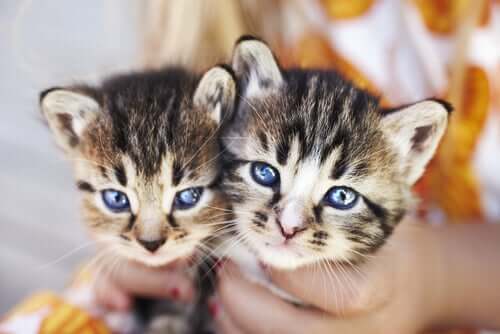Important Information About Eclampsia in Cats and Dogs


Written and verified by the lawyer Francisco María García
Eclampsia in cats and dogs is decalcification that results from nursing. In general, this appears one month after giving birth and is more common in female dogs than in cats. In the following article, we’ll tell you more about this nutritional disorder.
The reasons why eclampsia in cats and dogs appears has to do with delivery and diet. It’s more common in first-time mothers with large litters.
There are also cases where hypocalcemia or eclampsia appear at the end of pregnancy and during birth. This is mainly the result of a lack of nutrition in the mother.
Eclampsia in cats and dogs can occur in any breed. However, smaller dogs are more predisposed because the relationship between their size and their litter is too much for the animal’s physical conditions… among other reasons.
Symptoms of eclampsia in cats and dogs
Cats and dogs with hypocalcemia or eclampsia appear disoriented and weak. Their attention towards their litter may be lacking and they may seem nervous and upset. They may also experience considerable weight loss, have difficulty breathing, or pant constantly.

The mother’s body may move erratically. For example, you may observe spasms and rigidity, including the extremities, and characteristics that are visible in the face. In the most serious cases, dogs will also experience diarrhea, vomiting, and convulsions, as well as arrhythmia and tachycardia.
There are certain canine breeds that are more prone to suffering from this illness. For example, mini Pinschers, chihuahuas, poodles, toy poodles, and Shih Tzus. This is because they tend to give birth to a large number of puppies which places a higher demand on their physical abilities.
How to help animals with eclampsia
Eclampsia in cats and dogs can be deadly. Therefore, it’s important to take this illness very seriously and not downplay any of the symptoms. Rather, if you observe any of the signs or suspect hypocalcemia, you should seek the attention of a specialist without delay. The veterinarian will be the one to tend to your pet and prescribe the appropriate treatment for these cases.
In general, medication will help stabilize the decompensation of your dog or cat. Your vet may prescribe anti-seizure medications, muscle relaxers, and plenty of hydration. At the same time, solutions or calcium supplements can help your pet’s body recover from decalcification.
Most often, the new mother will need to be hospitalized in order to receive intervenous treatment. This form of treatment is much more comfortable and effective for animals.
It’s worth pointing out that the mother won’t be able to nurse her young during this time. As a result, the litter will need to get its nourishment from other nutritional formulas or artificial milk.
Preventing eclampsia in cats and dogs
- Just like with any other illness in animals, observation is fundamental in identifying any problems.
- Animals rely greatly on their natural instinct when it comes to giving birth. However, tending to them during delivery can reduce the risk of illness. In the same way, it’s best to pay attention to them during the postpartum period.
- Animals that have recently given birth should receive a healthy diet. Remember that many of their nutrients will be absorbed by their puppies while nursing.
- Nursing cats and dogs consume two or three times more food than normal. Their water intake also increases considerably, which helps them to produce milk for their young. Once a mother weans her babies, she’ll go back to her normal eating and drinking habits.
- There are some cases of dogs and cats that have experienced eclampsia which suffer the same again with subsequent litters. For these animals, a good diet will be their main means of prevention.
- Administering calcium supplements during the gestation period is a common mistake that owners make. Rather than helping, it can actually contribute to hypocalcemia. This is because the parathyroid glands won’t be active in order to know what to do with the amount of calcium received.

Recommendations for the lactation period in cats and dogs
There are three common illnesses that can occur during the lactation period in cats and dogs. These are eclampsia, mastitis, and insufficient or deficient breast milk. If a new mother experiences problems with her milk production, there are herbal and homeopathic treatments that can help this situation.
Once again, the best way to prevent any of these illnesses is assisting animals in the postpartum period. This involves observing and accompanying your pet during the period of lactation.
Just like eclampsia, mastitis puts the mother at risk… but it can also be dangerous for her babies. Since mastitis is an infection, a mother’s milk may be contaminated, and this can put their babies at risk.
Finally, fennel and borage help to increase a mother’s milk production. And, at the same time, borage possesses anti-inflammatory properties that can improve a mother’s recovery.
Eclampsia in cats and dogs is decalcification that results from nursing. In general, this appears one month after giving birth and is more common in female dogs than in cats. In the following article, we’ll tell you more about this nutritional disorder.
The reasons why eclampsia in cats and dogs appears has to do with delivery and diet. It’s more common in first-time mothers with large litters.
There are also cases where hypocalcemia or eclampsia appear at the end of pregnancy and during birth. This is mainly the result of a lack of nutrition in the mother.
Eclampsia in cats and dogs can occur in any breed. However, smaller dogs are more predisposed because the relationship between their size and their litter is too much for the animal’s physical conditions… among other reasons.
Symptoms of eclampsia in cats and dogs
Cats and dogs with hypocalcemia or eclampsia appear disoriented and weak. Their attention towards their litter may be lacking and they may seem nervous and upset. They may also experience considerable weight loss, have difficulty breathing, or pant constantly.

The mother’s body may move erratically. For example, you may observe spasms and rigidity, including the extremities, and characteristics that are visible in the face. In the most serious cases, dogs will also experience diarrhea, vomiting, and convulsions, as well as arrhythmia and tachycardia.
There are certain canine breeds that are more prone to suffering from this illness. For example, mini Pinschers, chihuahuas, poodles, toy poodles, and Shih Tzus. This is because they tend to give birth to a large number of puppies which places a higher demand on their physical abilities.
How to help animals with eclampsia
Eclampsia in cats and dogs can be deadly. Therefore, it’s important to take this illness very seriously and not downplay any of the symptoms. Rather, if you observe any of the signs or suspect hypocalcemia, you should seek the attention of a specialist without delay. The veterinarian will be the one to tend to your pet and prescribe the appropriate treatment for these cases.
In general, medication will help stabilize the decompensation of your dog or cat. Your vet may prescribe anti-seizure medications, muscle relaxers, and plenty of hydration. At the same time, solutions or calcium supplements can help your pet’s body recover from decalcification.
Most often, the new mother will need to be hospitalized in order to receive intervenous treatment. This form of treatment is much more comfortable and effective for animals.
It’s worth pointing out that the mother won’t be able to nurse her young during this time. As a result, the litter will need to get its nourishment from other nutritional formulas or artificial milk.
Preventing eclampsia in cats and dogs
- Just like with any other illness in animals, observation is fundamental in identifying any problems.
- Animals rely greatly on their natural instinct when it comes to giving birth. However, tending to them during delivery can reduce the risk of illness. In the same way, it’s best to pay attention to them during the postpartum period.
- Animals that have recently given birth should receive a healthy diet. Remember that many of their nutrients will be absorbed by their puppies while nursing.
- Nursing cats and dogs consume two or three times more food than normal. Their water intake also increases considerably, which helps them to produce milk for their young. Once a mother weans her babies, she’ll go back to her normal eating and drinking habits.
- There are some cases of dogs and cats that have experienced eclampsia which suffer the same again with subsequent litters. For these animals, a good diet will be their main means of prevention.
- Administering calcium supplements during the gestation period is a common mistake that owners make. Rather than helping, it can actually contribute to hypocalcemia. This is because the parathyroid glands won’t be active in order to know what to do with the amount of calcium received.

Recommendations for the lactation period in cats and dogs
There are three common illnesses that can occur during the lactation period in cats and dogs. These are eclampsia, mastitis, and insufficient or deficient breast milk. If a new mother experiences problems with her milk production, there are herbal and homeopathic treatments that can help this situation.
Once again, the best way to prevent any of these illnesses is assisting animals in the postpartum period. This involves observing and accompanying your pet during the period of lactation.
Just like eclampsia, mastitis puts the mother at risk… but it can also be dangerous for her babies. Since mastitis is an infection, a mother’s milk may be contaminated, and this can put their babies at risk.
Finally, fennel and borage help to increase a mother’s milk production. And, at the same time, borage possesses anti-inflammatory properties that can improve a mother’s recovery.
This text is provided for informational purposes only and does not replace consultation with a professional. If in doubt, consult your specialist.








